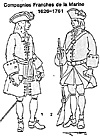In 1622 the "Compagnies Ordinaires de la Mar" were instituted to serve onboard the King's ships. Later, in 1626, they were transformed into the "Regiment de la Marine" for the same purpose and also to act as colonial troops. Finally from 1686 to 1690, 80 "Compagnies Franches de la Marine" were raised, each being attached to a seaport of France.
These Companies garrisoned the King's ships as did the troops of 1622, while thew also served as assault troops [like present day Marines] during sieges and colonial expeditions. That is the reason why they participated in campagns through-out South America [Cartagena de Indias in 1697, La Guadeloupe in 1703, Rio de Janeiro in 171] under the command of men such as Toueville, Duguay-Trouain and D'Estrees.
The Comagnies Franches de la Marine were under the responsability of the Ministry of the Navy, who was also in charge of the defense of the colonies as well as the coastal provinces of France. The officers were recruited amongst Naval officers. The first uniform appeared in 1690, the Compagnies were disbanded in 1761.
Cartagena de Indias - 1697:
Although a Franco-Spanish peace treaty had existed since September 17th 1768, acts of war, as well as piracy, carried on in the Americas between the two nations. Thus, Comte d'Estrees, chief of a fleet granted by the King, alongside Baron de Pointis with the buccaneer Grammont planned to assault Spanish towns in South America. In March 1697, regular troops, among them were the Compagnies Franches de la Marine, plus 1,200 pirates/buccaneers, boarded 30 ships, 7 of these being the K4ng's ships,and sailed for Cartagena. This expedition managed to capture the city of Cartagena, but after some discord between the regular troops and the buccaneers the city was pillaged. This course of action was later to be firmly condemned by the King of France and it put an end to the official support the buccaneers was used to from the French Court.
Rio de Janeiro - 1711:
With Portugal allied to England and Holland who were at war with France and Spain, in 1710 the French launched an unsuccessful attack against Rio de Janeiro, under the command Jean Francois Duclerc with 6 ships and 1,000 troops. Duclerc was made a prisoner and later executed, this gave the French a pretext to take revenge and another expedition was organised with Rene Duguay-Trouain [1673-1736] as commander. Its destination was Rio de Janeiro. This force was composed of:
- 3 x 74 gun vessels Lys, Mars & Magnanime
3 x 66 gun vessels Achille, Brillant & Glorieux
1 x 56 gun vessel Fidele
3 44 gun vessels Chancelier, Argonaute & Aigle
3 x 22/36 gun frigates Amazone, GloLeuse & Astree
1 x 38 gun schooner Bellone
This 740 gun strong Armada included 600 officers, 3,200 seamen and 2,500 soldiers, among which ranked the Compagnies Franches de la Marine.
On the 13th of September the French landed 500 men on the Ilha des Cobras, but launched the main attack from the beach of Saco do Alferes with 3,000 men, an hours march from Rio de Janeiro, on the 14th September. Francisco de Castro Marais, Governor of the city had 12,000 troops at his disposal, but not all of these were at the city, he abandoned the city before reinforcements sent by Antonio de Albuquerque Coelho de Carvalho from Minas do Ouro could arrive. On the 2nd October the Portuguese agreed to pay a ransom to the French so that Dugay-Trouain's expedition would sail for France on the 12th November 1 1711.
Uniform
 Colour details to the plate: Fig.1. Officer circa 1697, fiat black with gold lace and white feathers, coat white with medium blue cuffs and linings, medium blue waistcoatwith gold lace, medium blue breeches and stockings, white pocket flaps and waist sash with gold lace fringe, gilt buttons, black shoes.
Colour details to the plate: Fig.1. Officer circa 1697, fiat black with gold lace and white feathers, coat white with medium blue cuffs and linings, medium blue waistcoatwith gold lace, medium blue breeches and stockings, white pocket flaps and waist sash with gold lace fringe, gilt buttons, black shoes.
Fig.2. Soldier, circa 1709, Hat black with yellow lace and black bow, brass button and yellow holding strap, coat white, medium blue cuffs and turnbacks, white pocket flaps, brass buttons, waistcoat medium blue, black stock, breeches and stockings medium blue, white shirt, black shoes.
Compagnies Franches de la Marine Large Illustration (55K)
Sources:
Musee des troupes de Marine, Frejus.
Helkio Vianna, "Historia do Brasil", 1972.
A.Depreaux "Uniformes des troupes coloniales", 1931.
C.Farrere, "Histoire de la marine francaise", 1962.
Back to Table of Contents -- El Dorado Vol V No. 2
Back to El Dorado List of Issues
Back to MagWeb Master Magazine List
© Copyright 1992 by The South and Central American Military Historians Society
This article appears in MagWeb (Magazine Web) on the Internet World Wide Web.
Other military history articles and gaming articles are available at http://www.magweb.com